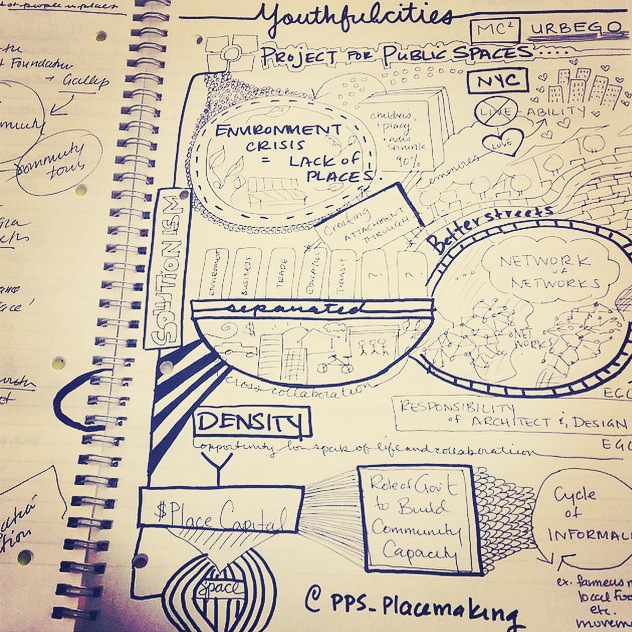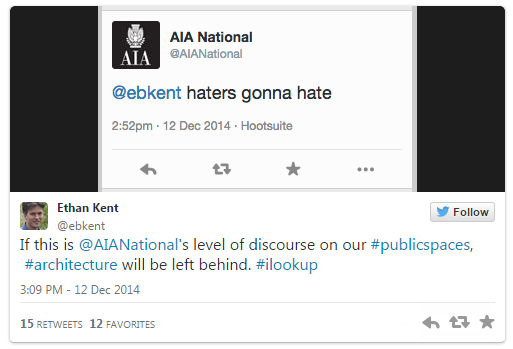A biweekly newsletter with public space news, resources, and opportunities.
A curated dispatch on all things public markets plus the latest announcements from the Market Cities Program.

This past week, the American Institute of Architects launched a new campaign entitled #ilookup, aimed at raising awareness of what architects think about when they create the buildings in our cities. What they missed, however (equity discussions aside), was the recent paradigm shift taking place in our cities that has been going on for the last several decades - that of the spaces inbetween buildings and the Placemaking that supports the people who inhabit them.
Designing buildings is an important task to be sure - no one doubts that, and I’m happy there was an architect to design the building where our office resides so that I can have a place to work comfortably. But as a recent NYTimes op-ed “How to Rebuild Architecture” puts it:
“We’ve taught generations of architects to speak out as artists, but we haven’t taught them how to listen. So when crisis has called upon our profession to step up — in New York, for example, post-9/11, and in New Orleans after Katrina — we have failed to give the public good reason to trust us. In China and in other parts of Asia, Western architects continue to perform their one-off magic, while at the same time repeating many of the urban design catastrophes of the previous century, at significantly larger scales.”
The worst of architecture is when the emphasis is too much art, not enough people or place. What comes out of this is typically referred to as Starchitecture - the ego-driven buildings that seem to purposefully aim not to connect with their surrounding urban fabric (like the Guggenheim for example, or the top designs for the new Guggenheim in Helsinki).
The #ilookup campaign seems to emphasize this oft-cited problem with the field of architecture by further focusing on the grandiose vistas, while ignoring the most important part of a building for a city and its citizens - the ground level. When faced with this critique on Twitter, the dialogue was lost, again reinforcing the starchitect mindset.

Alternatively, we should be working towards an Architecture of Place: A way in which architecture can work within the existing urban fabric and collaborate with the community to best design for their needs. This Place-led development requires that the nature of the surrounding area is prioritized and goes beyond simply being project-driven or place-sensitive.
The question is: how can we improve this process and break down barriers to progress?
This week we launched a collaboration with EDRA on their 2015 Great Places Awards competition which considers places in their entirety—as dynamic and inclusive lived environments that engage our attention and imagination. Further, projects that are not in solely one profession or discipline are preferred, and research projects and books are award categories in their own rights.
Awarding designs and projects that focus on people makes sense, and is one step towards highlighting projects that use Placemaking to the advantage of everyone. Adding social science to the status quo would be another step forward. As a recent Guardian piece on “smart” cities notes: “A smarter way” to build cities “might be for architects and urban planners to have psychologists and ethnographers on the team.”
“After all, as one of the tribunes asks the crowd in Shakespeare’s Coriolanus: ‘What is the city but the people?’”
Precisely. A city is made up of people - walking around, looking forward.
To keep up with all this (and more) be sure to sign up for our newsletter and follow us on Facebook, Twitter, and Instagram for Placemaking news from around the world and an inside peak into things here at PPS.
The rich text element allows you to create and format headings, paragraphs, blockquotes, images, and video all in one place instead of having to add and format them individually. Just double-click and easily create content.
The rich text element allows you to create and format headings, paragraphs, blockquotes, images, and video all in one place instead of having to add and format them individually. Just double-click and easily create content.
Body Text Body Link
The rich text element allows you to create and format headings, paragraphs, blockquotes, images, and video all in one place instead of having to add and format them individually. Just double-click and easily create content.
Here is some highlighted text from the article.




Headings, paragraphs, blockquotes, figures, images, and figure captions can all be styled after a class is added to the rich text element using the "When inside of" nested selector system.
Headings, paragraphs, blockquotes, figures, images, and figure captions can all be styled after a class is added to the rich text element using the "When inside of" nested selector system.
Headings, paragraphs, blockquotes, figures, images, and figure captions can all be styled after a class is added to the rich text element using the "When inside of" nested selector system.